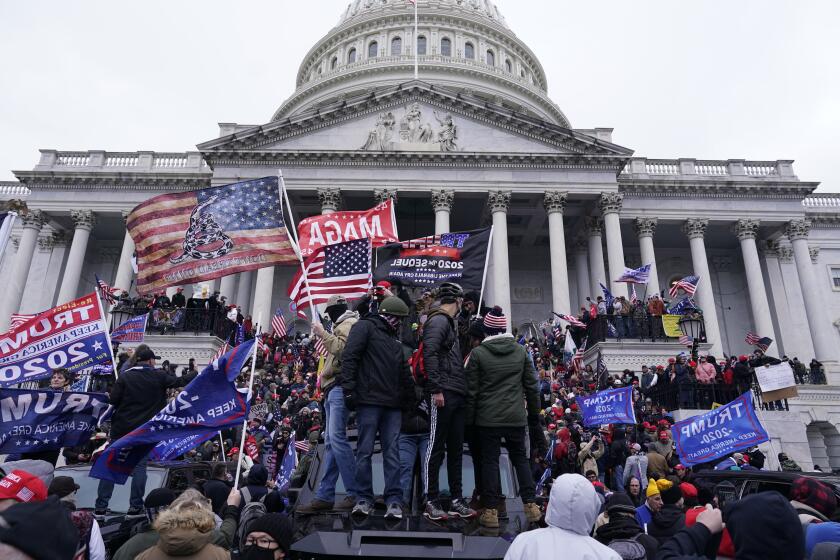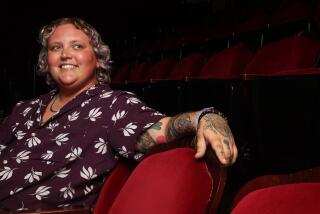‘A Town Called Victoria’ shows how 2017 mosque arson rocked tight-knit Texas community

- Share via
In the opening scenes of “A Town Called Victoria,” we see an aerial view of green pastures dotted with the occasional house. A couple of Brahman cows stand in a field before it cuts to the Texas town’s historic downtown.
This idyllic town was forever altered when it became the center of national attention on Jan. 28, 2017, after a fire broke out at a mosque — the only one for about 100 miles around. The Victoria Islamic Center was founded in 1984, and the blackened frame was what remained, its interior turned to ash. The fire came hours after then-President Trump signed an executive order banning the entry to the U.S. of people from seven majority-Muslim countries.
The timing of the fire turned out to be no coincidence. Investigators determined it was arson, and Marq Vincent Perez, a Victoria resident who was 24 at the time, was charged with setting the blaze, which federal authorities deemed a hate crime.
At the federal trial, a confidential informant told the jury that he was at the mosque with Perez, and photos Perez took at the scene, along with social media messages where he denigrated Muslims and communicated with a leader of the anti-government militia group Three Percenters, were entered as evidence. Perez was convicted of the arson and the hate crime and is currently serving a prison sentence of more than 24 years.
But “A Town Called Victoria” isn’t just about the crime. The three-part PBS docuseries, premiering Monday, tells the story of the people affected, how the community responded and how the mosque was rebuilt. It also provides historical context about the racism and xenophobia that permeate the region to this day. The documentary follows the leaders of the mosque — Abe Ajrami, Omar Rachid and founder Dr. Shahid Hashmi — as well as other figures in the community. Also interviewed are Perez’s parents, who maintain their son’s innocence.

Director Li Lu (“The Resident,” “Echoes”) grew up in Sugar Land, a Houston suburb, and she remembers first reading about the fire on social media from posts shared by longtime friends, shortly after it happened. “Some classmates … knew people very intimately that went to that mosque,” she said.
For as big as Texas is, there is an intimacy to its smaller communities. I was born in Victoria, and my family lived there until I was about 7, when we moved to a nearby town. But I was a frequent visitor, not only because my extended family lived there but also because it’s the economic center of the region. It’s home to several chemical and industrial plants, two hospitals, a couple of colleges (I took summer classes at one) and the area’s only shopping mall. And despite the change and growth over the decades, Victoria manages to maintain the feeling of a small town.
News travels fast there because everyone seems to know each other — and that’s what the documentary tries to show. The members of the mosque are a mix of converts to Islam and immigrants and refugees from Middle Eastern countries who have woven themselves into the fabric of the city.
“It’s interesting, the different kinds of trades that they occupied, from the medical field to the oil and gas industry to education as well,” Li said. They own local businesses; they serve as youth soccer referees and on community boards; and they maintain relationships that cross race, religion and political parties. Rachid, one of the mosque’s leaders, even ran for mayor. “The series was made to be rhetorical in a way, to say, ‘Am I involved in my community?’” Lu said.

Li spoke about her docuseries and how the events in Victoria are a microcosm of the divisive politics that have frayed communities and how those tensions remain with a national election on the horizon. She also spoke about late “Rust” cinematographer Halyna Hutchins, who worked on the docuseries; it’s among her last projects to be released posthumously.
This interview has been edited and condensed for clarity.
Do you feel like your docuseries is a way of demonstrating how divisions have been taking hold in communities across the country?
I think the election cycle in 2016 really changed the way that small towns operate and [how] people relate to each other, especially in small communities where your currency is how you’re relationally tied to somebody else. Because it’s such a small community where people have to depend on each other, it is about the strength of the collective in many ways. If you have some trouble, you can call on people to help you out.
Something about this national election cycle, and the national noise of that moment, really changed the DNA of communities like Victoria. Omar, Abe and Dr. Hashmi were able to get by the previous one much because they were all on the good graces of their reputations. But something about the sea change after 2016 labeled them as Muslim before [acknowledging] any of the things they had done personally to show the community they really cared about it.
The Muslim community in Victoria seems very tight-knit, and you show how its members were involved in the town. Could you talk about that?
It’s a very unique mosque because the common language there is English. You have this beautiful tapestry of people from all around the world that’s also, conversely, from the town or Americans themselves in a way. And there’s many people who had been there for a long time, like founder Dr. Hashmi [a surgeon at one of the local hospitals], who’s been there since the ’80s and really grew this community from the ground up. The mosque was a personal design [of] his too. He says, “Losing that was like losing one of my children.”
The people you interviewed from the Islamic Center seemed to struggle with how others perceived them. They were integrated into the community, but you could see that they were also hurt by people’s perceptions of them.
We [immigrants] all come from different crises and wars and conflicts to find a little bit of peace here in Texas, whether it be a small town or a big city. There is this gratitude and graciousness that folks feel to this town, coupled with the stark reality that this hate crime occurred to your community. And the stark realization that there are a lot of sharp edges for folks in towns like this as well.

You spoke to several religious leaders in the community, many of whom offered their help and support to the Islamic Center. The Jewish synagogue in town, for example, offered its temple for services. How did the different faiths come together?
Victoria is very interesting because there’s so many different houses of worship and congregations. There’s also a Catholic convent in town. It’s been there since Victoria’s founding. It’s deeply rooted in religion. It was really beautiful, especially for the members of the mosque, to see a true coalition of different faith leaders and congregations come to the rally the next day [after the fire], to showcase that this is not what we think of you [and to] put our arms around you.
What about those that didn’t speak up?
A pastor [Mike Hurt] of a huge church [Parkway Church] spoke very publicly against the peace rally [that was held after the fire] and what it means to equate religions in a way and to equate the validity of religions and their God versus our God. A lot of those conversations were happening in the town and through larger houses of worship as well because it just feeds into the conservative nature of the town and what they thought of Muslims from a policy and national lens.
When Perez was named the suspect and charged with arson, a lot of community members you spoke to seemed surprised because he was Latino. But some weren’t. Do you think it presented a different idea about assimilation and how people integrate into communities?
I think for a lot of folks, they understood that the story was so much deeper, because this is South Texas. The history of Texas, thinking about power and race and land, it really called for a sense of historical context ... how is it that a person who’s also from a marginalized community himself could possibly be the perpetrator [of] this hate crime toward another community of color? And it’s the hardest conversation to have. But I think it’s a nuanced and necessary one, because if we can’t pick apart the ingredients of white supremacy, the ideas behind power that attract folks to feel powerful themselves, I think we’re doing a disservice to this moment right now that we’re having in this country.
So much of what it feels like to be raised in marginalized communities in Texas is a psychological imprint of self-worth, of masculinity. All these validators that either tell you that you are in power or you don’t have it. ... Having seen a lot of that myself growing up in Sugar Land, it really made me feel like there was a whole side of this story regarding the arsonist, his upbringing and his family that needed to be told.

When you were in Victoria filming during the trial, did you sense tension in the community?
This is something that never really came through any interviews, but I felt like it was easier to convict Vincent because he was a person of color as well. ... People always asked, “Who were his allies?” And the sad truth is no one. Not from the church he attended; just his family and a few aunts and uncles. I was there every single day of the trial. And for all the buy-in that this family had toward their church … they really had no one to even sit there with them on their side. … There was incredible tension within the Muslim community, hoping that the justice system would do right by them. But as Irfan [Qureshi, an Islamic Center member and physician] says after the trial, no one takes joy in it.
I remember the scenes of [Perez’s parents] walking alone, hand in hand. No one else was there.
The profound sadness of the story of Vincent is that here is a young man who was trying so hard to be accepted by these other places and groups of power — these militia members and joining the armed forces, his dream of serving. [Perez joined the Air Force but was discharged after five weeks.] The saddest thing is, he basically destroyed everyone who wanted to care for him or loved him. His parents, his partner, his children. These are all people who wanted to include him in their lives. And he pushed all that away to seek validation from these other entities.
Why so many military veterans and former and current police officers support — and take part in — far-right groups and protests, including the Jan. 6 Capitol riot.
We’ve seen a lot of that lately, with the Jan. 6 insurrection and people like Enrique Tarrio, who is Afro-Cuban but was the leader of the Proud Boys. It seemed in some ways like a microcosm of something playing out on a larger stage across the country.
That’s what kept us going. We just felt like this was a blueprint for every community everywhere. It could be as big as Los Angeles, or as small as Victoria, but every community has these ingredients, for better or for worse.
You also show a few different political rallies and conversations with political leaders in the state and the community. Do you think they share some responsibility in terms of the anti-Muslim rhetoric or how this case was viewed in particular?
In terms of the attention this got, it was really based in the timeline of the travel ban, a timeline of so much anti-Muslim rhetoric. [Sen.] Ted Cruz had very publicly advocated for patrolling of … Muslim neighborhoods — things that honestly didn’t make much sense. … It’s also about how this incident became a talking point in election cycles too.
Have you spoken to the members of the Islamic Center since? How do they feel about how relations in the community have changed or not since you filmed the documentary?
When you condense almost six years’ worth of experience into three hours, it really showed them the hard path they had to walk and then survive.
But I have to also say a lot of folks feel a disconnect, even with their beautiful building now, which is the bittersweet ending. Something was inherently lost, it could never be brought back again, which is a sense of safety and a sense of “this is our place.” This is a place where kids grew up; weddings happened all the time. Every Friday, they had a potluck. And for some members, they feel like they don’t have that connection with a new place. And maybe that can never be brought back again.
Cinematographer Halyna Hutchins was killed on the set of “Rust” in October 2021. A judge dismissed the involuntary manslaughter case against star Alec Baldwin in July 2024.
Lastly, I saw that you worked with Halyna Hutchins on this project, and you dedicated the first episode to her. What was it like working with her, and how did she make her mark on the film?
Halyna was my first creative collaborator on this project. She and I had known each other for many years prior to starting this in 2017. And she had a background working in documentary in Europe before coming to the States. She’s a true artist, and she connected so personally with all of our key characters. I’m really honored that this piece can be a celebration of her artistry and her life and her fight for injustice, because the injustice of what happened in Victoria touched her very deeply. And the injustice of her death, I think, demands an answer. So I’m very honored that this will enter her filmography — something that means a lot to both her and me.
More to Read
The complete guide to home viewing
Get Screen Gab for everything about the TV shows and streaming movies everyone’s talking about.
You may occasionally receive promotional content from the Los Angeles Times.








